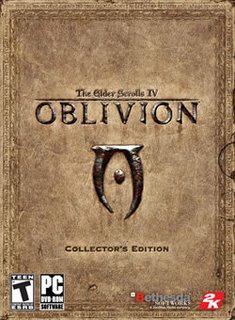
Release date: 1990
Director: Jim McBride
Contains spoilers
Another movie watched on the Horror Channel (UK), but one that was much more worthwhile than some of the channel's titles. “Blood Ties” is a most interesting movie.
It begins as a group of hunters attack a farm. They stake the husband and wife in bed. The noise wakes their teenage son, Cody Pucket (Jason London). As he walks into their room, the marital bed is set ablaze. He is shot in the side by a crossbow. He escapes the inferno and the hunters let him go, believing he will lead them to “the others”.
We flip to Long Beach, California and Butch (Salvator Xuereb), member of the bike gang the Shrikes, is on trial for the normal juvenile delinquent stuff. He is being prosecuted by Amy Lorne (Kim Johnston-Ulrich) and the case is being covered by reporter Harry Martin (Harley Venton). Harry is related to Butch distantly and realises that Butch’s uncle Eli Chelarin (Patrick Bauchau) has bought off the jury.
Harry visits Eli after the trial and tells him about the farmhouse attack. Around this time Cody arrives in Long Beach – he later reveals his parents told him not to go to the sheriff if something happens but to find Eli – and is met by the Shrikes. They take him to see Eli – during Eli’s birthday party - and our attention is drawn to the pendant of Lilith he wears.
This is where the movie becomes interesting. Given the nature of the blog it must be clear that the family are vampires, but the film redefines the rules. These vampires are a different race – tracing their lineage back to Lilith it seems. They do not fear the cross, are not effected by the sun. Whilst a stake will kill them, so will a car accident. They do heal more quickly than humans, they are up to 30% stronger, can climb precarious walls and we discover their previous generations used to live in caves, drop on travellers from trees, gorge on their blood and then lie where they fed, like bloated ticks. They are not immortal, living to approximately 130. These are far from supernatural creatures, and they do not use nor like the name vampire, preferring instead the ethnic label of Carpathians. It is also made clear that vampires and humans can interbreed, and hints that perhaps some or all of the hunters are half breeds.
Obviously the hunters are after them, and when Eli’s sister Celia (Michelle Johnson) is captured, and nearly burned at the stake, a showdown ensues.
The film is about religious fanaticism and racism. It is about ethnic identity and integration. In amongst the film is an underused sub-plot about a (potential) love triangle between Harry, who seeks integration with humanity, Celia and the human Amy.
If there is anything wrong with this film it is that it feels a little cheap and at times empty. The love triangle is not explored fully and the story itself is very simple. That is a shame because the premise is unique and the messages strong, and I believe that the film deserves much more substance than the script allows it. For example Harry explains to Cody that his parents had left California, to settle in the anonimity of the Texas countryside because they wanted him to have a normal integrated life. They went as far as to not reveal his true nature to him. This could have been expanded upon greatly.
In some respects it feels very much like a pilot for a TV series, with hints of stories left for expansion in the full show. I know it was a TV movie, so perhaps that had always been the plan?
Celia is underused, however there is a stand out moment where she is chained to a chair and gagged. She squirms, at first it looks like she is trying to break her bonds, but instead she is trying to get her blouse buttons to pop. Cleavage revealed she manages to lure her guard towards her and then leaps, still chained to the chair, and bites his neck through her gag. It is a rare example of escape (though her attempt fails ultimately) through blouse button manipulation – without the use of hands.
I must also mention the Shrikes. This movie was early 90s but the gang look more like some bad Miami Vice extras in their very 80s outfits. Certainly they are not as cool as the Lost Boys (1987).
That said this deserves a robust score, if for nothing else, for its distinctiveness. I’ll give this one 7 out of 10.
The imdb page is here.
Friday, March 31, 2006
Blood Ties - review
Posted by
Taliesin_ttlg
at
7:27 AM
2
comments
![]()
Thursday, March 30, 2006
Vampires Rock
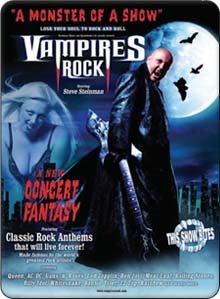
For vampire fans in the UK, note that the stage show Vampires Rock is on the road again. This is a musical show by Steve Steinman with a vampiric theme.
I saw the show last year and it is great fun. However, don't expect a huge in-depth story. The vampire story is functional enough to hook the tracks together, where the talented band covers bands such as Queen, AC/DC and Meatloaf. However there is some nice imagery and it is a great night out.
An interview with Steve is here.
Posted by
Taliesin_ttlg
at
10:19 PM
0
comments
![]()
The Buffy Syndrome

The vampire genre seems to be very popular at the moment, but it always has been. I think it safe to say that there are more vampire movies than any other specific genre. Yet the resurgence over the last few years has been phenomenal. Is this all down to a blonde vampire slayer?
“Buffy the Vampire Slayer” was a series that ran seven seasons from 1997 to 2003, and spawned a five-season spin-off series, “Angel”. It came from a 1992 feature movie, than in all fairness was a flop – though I must admit I do have a soft spot for the movie. Despite the title, Buffy was not entirely concerned with vampires; she fought against a plethora of demons and supernatural beings and relied on the “boggle effect”. The “boggle effect” is where something is so weird that the observer’s mind chooses not to see it. This was used to good effect by the writers, disbelief did not need to be suspended too far as the writers intimated that all this was really occurring, but ordinary folks simply refused to see it. The series was also aided by some sharp writing, though occasionally hindered by a tendency to drift towards the maudlin and, certainly in later seasons, the inclusion of some very whiney characters (Dawn, we look to you – though in the series the writers actually confronted this tendency when the character Willow became evil and confronts Dawn about her endless stream of low grade angst).
Love it or hate it, it is clear that Buffy will have had some impact on the number of vampire movies and books being produced, indeed its influence (along with the X-files) can be seen in the sheer number of paranormally based TV series. However, was it the only influence?
There has been a slough of, what we could call, phenomena books but I shall concentrate on one of the more popular series. The Anita Blake novels by Laurell K Hamilton are very popular. They centre on Blake, a feisty brunette who is a state authorised vampire executioner. To all intents and purposes this sounds very Buffyish. Unlike Buffy, Blake is not a chosen one and has no intense strength. As we meet her she is not only the executioner, but also a raiser of zombies. She does gain in power as the series develops, but this power stems from her relationship with a vampire, Jean-Claude, and a werewolf, Richard. The gain in power also seemed to coincide with Hamilton’s plots loosing place to much more erotic fiction – these books are aimed fairly and squarely at an adult market. In the books, in a premise quite different to that of Buffy, the supernatural is very much a part of modern society. Vampires are out of the closet. Anita raises zombies to settle testate issues and lycanthropes are finding that they face discrimination in the workplace due to their conditions.
In the books, in a premise quite different to that of Buffy, the supernatural is very much a part of modern society. Vampires are out of the closet. Anita raises zombies to settle testate issues and lycanthropes are finding that they face discrimination in the workplace due to their conditions.
However, the temptation is to state that Blake owed all to Buffy (and I think here I am referring to the series and forgetting the movie). However the first book, “The Laughing Corpse”, was published in 1994, some three years before the series aired. The increasing popularity of the series might tie in with the phenomenal popularity of the Slayer, but Hamilton created her own franchise that is very popular in its own right. Another major influence on the genre has been through the books of Anne Rice. Starting with “Interview with the Vampire” published in 1976, the impact of Rice’s work cannot be underestimated. However, as popular as Rice’s “Vampire Chronicles” are, they did bring to the fore the syndrome of the whinging vampire. The character Louis redefines misplaced angst, as does Marius in the later book “Blood and Gold”. The upshot of this is a trend for vampires unhappy with their lot in life, tortured and moody. Hmm… Sounds very much like Angel from the Buffy franchise. This development is not, necessarily a good one as vampires (in my opinion) are at their best when they revel in their condition – hence Spike being a much better character in Buffy – however it does indicate the amount of influence Rice has had.
Another major influence on the genre has been through the books of Anne Rice. Starting with “Interview with the Vampire” published in 1976, the impact of Rice’s work cannot be underestimated. However, as popular as Rice’s “Vampire Chronicles” are, they did bring to the fore the syndrome of the whinging vampire. The character Louis redefines misplaced angst, as does Marius in the later book “Blood and Gold”. The upshot of this is a trend for vampires unhappy with their lot in life, tortured and moody. Hmm… Sounds very much like Angel from the Buffy franchise. This development is not, necessarily a good one as vampires (in my opinion) are at their best when they revel in their condition – hence Spike being a much better character in Buffy – however it does indicate the amount of influence Rice has had.
As much influence that Buffy and series such as “Vampire Chronicles” and “Anita Blake” may have had, however, they pale into insignificance compared to the influence that Dracula has had. Since its publication the book has not been out of print, there are studies of the book printed, novels as prequels, sequels and re-writes. The character Dracula has been in more movies than you can reasonably shake a stick at. “Bram Stoker’s Dracula” (1992) is a point in case, with a screenplay based on the novel and then a further novellisation of the screenplay by Fred Saberhagen, which whilst it might be useful from a collector’s point of view was probably one of the most unnecessary novellisations ever.
“Dracula” is so influential that, even when the character is not part of a story he is often mentioned in unrelated stories. This is often because it is clear that the writer cannot conceive of a world where the name Dracula is not known to one and all. Anne Rice mentions the book in the screenplay of “Interview with the Vampire” (1994), Louis brands the book “the vulgar fictions of a demented Irishman.” Similarly, in the movie Midnight Kiss (1993) the cops joke about putting an APB out on Dracula. In Buffy, Dracula himself makes a guest appearance.
The influence of Buffy has been great, and it certainly has kept the  genre in the limelight. Yet it is not the only modern influence on the genre and shows such as Buffy, plus novel series such as those created by Rice and Hamilton both influence and popularise the genre. However none can hold a light to “Dracula”, whose influence seems to stretch through the centuries like a distorted shadow with a will of its own.
genre in the limelight. Yet it is not the only modern influence on the genre and shows such as Buffy, plus novel series such as those created by Rice and Hamilton both influence and popularise the genre. However none can hold a light to “Dracula”, whose influence seems to stretch through the centuries like a distorted shadow with a will of its own.
Posted by
Taliesin_ttlg
at
10:06 AM
4
comments
![]()
Tuesday, March 28, 2006
Vampire Phantasm - Orlock Competition

The Vampire Phantasm Orlock fan fiction competition has reached its conclusion. Unfortunately, my entry "Because the Night" didn't place this time. The winner was "A Splinter In My Side" by Sami Gibbs - well done to you.
The link will take you to all the entries.
Posted by
Taliesin_ttlg
at
2:35 PM
2
comments
![]()
Monday, March 27, 2006
Wine for the Gods

Falling.
Spinning in a wild satellite orbit,
Towards the Ground,
Captured in a slow motion pose.
Scarlet sphere of a natural perfection.
Striking down into the red pool,
Cascade of crimson hue follows impact,
Like the explosion of fireworks
On a cold November night.
Fascinating – even hypnotic.
Next sphere in descent,
I place my wine glass below it.
Scarlet stains adorn glass base,
Hits the wine, spread of fire,
Like the glory of the sunrise.
Capturing your slow spilling blood,
Infusing you into my wine.
I shall become intoxicated
Upon your love,
My darling.
© November 1990, A M Boylan
Posted by
Taliesin_ttlg
at
4:57 AM
0
comments
![]()
Sunday, March 26, 2006
Oblivion
Just a quick update to say that as I am currently sucked into the joy that is "The Elder Scrolls 4: Oblivion", things might slow down a little on the blog - however I will endeavor to ensure that things do not fallow.
In related news, in Oblivion you can contract vampirism. I was considering putting my character in the line of fire - so's to speak - and then reporting back here as to what playing a vampire in the game is like. Unfortunately, I have discovered that, in a bizarre logic twist, Bethseda have made it that your vampire becomes weaker the more blood it drinks... sounds illogical to me.
Posted by
Taliesin_ttlg
at
9:07 AM
1 comments
![]()
Saturday, March 25, 2006
Midnight Kiss - Review

Release Date: 1993
Director: Joel Bender
Contains spoilers
Bless the Horror Channel (UK), it might show some utter rubbish, but it does allow you to catch vampire movies you might otherwise miss and some of them are pretty good. In this case, however, the film is not the best I have ever seen but it at least had its moments.
The film opens with a woman at a bar, she is being aggressively approached by a sleazy guy and leaves. She is cornered at her car by the drunk, who will not take no for an answer. A priest approaches, though we immediately know by his demeanour that he is in actual fact the vampire (Gregory A Greer). His long blonde hair is scraped back and he has a cross earring in (so we already know that vampires are not effected by the cross in this movie). He is stabbed through the hand by the drunk, picks the guy up and pokes his eyes out. The barman comes out and blasts the vampire in the chest with a shotgun, to no effect. He takes the gun, shoots the barman and then blows his head off. Finally he feeds upon the woman.
It is a very gory opening for what looks and feels like a made for cable TV movie.
The cops come and we discover that the woman is the 6th victim found drained of blood. Carrie Blass (Michelle Owens) arrives on the crime scene. As the film enters a period of exposition we discover that she is an ex-homicide detective who, having made a mistake, is now on the rape crisis squad (it seems the victim was also sexually assaulted by the vampire and thus she gets herself onto the crime scene). Carrie wants to be a homicide detective again. There is a problem with that, however, the lead detective on the case is her ex-husband, Dennis (Michael McMillen), and Captain Nicoletti (Robert Miano), who is the man with the final say, is the worst kind of sleaze – but more on that latter.
Another woman is attacked, this time by the vampire wearing a business suit – it does seem he likes to don costumes. She manages to get to her car. The car alarm is blaring and, in a bizarre moment for such a film, the vampire punches through the hood of the car and rips out the alarm. I assume it was the alarm as, not only does the alarm stop, but she is able to drive away. The police question the girl in the most aggressive of manners, and cannot even get a description out of her. Carrie approaches her and gets her talking, she also notices that the girl has been bitten on her arm.
Carrie tries to get on the case, offering herself as bait for the killer. Eventually, following advice, she goes on a date with Nicoletti as it is the only way she will get reinstated into homicide. He takes her to a strip joint. Now this is one of the problems with the film. All the male cops, with the exception of Dennis who isn’t quite as bad, are portrayed as misogynistic and unsympathetic and, to be frank, they would all have been sacked many years previously. Nicoletti is, of course, the worst. He gives jobs to female cops on the basis of them sleeping with him and takes women to strip clubs. Perhaps the scene was designed to show him in the worst light, but I suspect it was an excuse to show some T&A.
Carrie threatens Nicoletti with internal affairs and gets the job. To cut a long story short, she is eventually bitten, when returning to her apartment, by the vampire (dressed as a milkman) – though she escapes by shooting him point blank in the head. At this point Carrie starts to change. It starts with a dream of a cross, blood and fangs. She wakes goes to the fridge, pours milk which pours as blood and wakes again. This is a problem, the dream is clichéd and illogical. Why a cross? We’ve already established that vampires are not affected by it. The waking into a second dream is a much too used cliché and the pouring milk that is really blood has been done too many times, to best effect by “Thirst” (1979). However, what is nice is that her bite is bleeding and she has blood on her mouth – she fed from her own forearm in her sleep. Carrie’s demeanour changes, she dresses more sexily and becomes increasingly violent. Eventually she realises what is happening.
With the disbelieving Dennis she goes to the morgue to find two of the victims rising – but why did it take so long? Having staked them she leaves Dennis to cut off their heads and goes to the other survivor’s home. There are some scenes of gore through the house and the woman has completely vamped. Another staking and home for a confrontation with the vampire. After a disappointing battle she stakes him, but he pulls it out. So, in quite a unique ending, she stakes him through the neck and he immolates. With him dead Carrie is free from the curse.
Greer does a good job as the vampire. He looks the part and is completely barking mad. There is a scene of him walking down an alley with a neon sign behind him saying “Wacko” – not by accident I feel. There are some nice touches with him, he sleeps in a body bag and has a nice set of double fangs. He is only ever referred to as the vampire, and there is no explanation of his past, which makes him nicely mysterious. It is interesting that IMDB lists “Midnight Kiss” as the only film that both Greer and Owens have appeared in, as these two give the strongest performances it seems a shame, if that is accurate.
The rest of the cast range between average and poor. “These hands are lethal weapons!” cries the first surviving victim posing in a really bad faux kung fu stance when she is attacked. It does, however, lead to the nice retort from the vampire, “So are these.” as he Holds up clawed fingers. The direction is functional, (EDIT, bender edited and did not direct Vlad) but Bender did go on to edit the vastly superior “Vlad” (2003). The main problem with the film is you spend your time trying to dodge the clichés, but it is a nice distraction for 85 minutes. Scoring this I thought of giving it 3, but it was too low, and 4, but I felt that was overly generous so I’ve settled for 3.5 out of 10.
The IMDB page is here.
Posted by
Taliesin_ttlg
at
5:44 AM
0
comments
![]()
Labels: strip club/stripper, vampire
Friday, March 24, 2006
Durham Red: The Scarlet Cantos – review

Written by: Dan Abnett
Illustrated by: Mark Harrison
Contains spoilers
The “Scarlet Cantos” is a “2000 AD” graphic novel, based on the character Durham Red. The character was once part of the Strontium Dog series, born and raised in the mutant ghetto of Milton Keynes in the 22nd Century. She joined the Strontium Dog bounty hunters, a group made up of mutants. Durham’s mutation was vampirism, thus it is not of a supernatural origin.
This is all before the graphic begins, in the novel it is 1200 years later. Red had put herself into suspended animation, as she was disillusioned with life. Since her sleep the Bloodshed occurred, a devastating war between humans and mutants. A false peace fell across the galaxy, but a religious resistance sect of mutants, the Tenebrae, have begun to worship Red – or Saint Scarlet as she has become known – as a goddess.
The humans have also fallen into a deeply pseudo-religious society, and have a ruling force known as the Iconoclast – a futuristic inquisition. Red’s animation chamber is found and she is awakened by Tenebrae agent Judas Harrow. When Iconoclast forces try to kill her, confused that their vampire wards do not work against her, she bites Matteus Godolkin. He believes that he must be in her thrall and thus must obey her. This is a fantastic concept, Red’s vampirism is not at all supernatural and it is his belief that forces him to serve her.
The novel follows the adventures of the three as the second Bloodshed falls across the galaxy in Red’s name as a false Red leads the mutant forces against humanity.
Whilst there are plenty of science based vampire stories/movies, and even some involving extraterrestrials, this is a space opera in the grandest scheme of things, actually fairly rare as a vampire genre piece, and it has beautiful artwork worthy of the vast vista it paints. The story, in itself, is very good and many of the rules of the game become readily apparent.
It is perhaps better read with some knowledge of the back history, and though there is a précis at the front of the novel and some excellent exposition when the companions search out artificial intelligences from Red’s time, a full background from the comic books is probably worthwhile.
The language can be unusual at times, whilst the setting is the distant future, the religious dialogue is almost medieval and this might put casual readers off. That said, juxtaposing the religious overtones of the majority of the characters with the down to Earth dialogue of Red works very well indeed.
Many of the concepts are wonderfully bizarre. The planet Wodan, an engineered wooden world is a unique creation and I love the symbolic weaponry wielded by the Iconoclast forces; the bolter, which blast fires a staking pin, the burner that cleanses with flame and the silver blade that severs the neck. I also love the idea that Red insists on using an antique weapon, from her own time, that often jams.
The “Scarlet Cantos” is not a casual read; I found I gained a lot more from it when I re-read the novel. It is the sort of graphic novel that would cost an absolute fortune if it were to be ever translated to film. 8 out of 10.
Posted by
Taliesin_ttlg
at
9:05 AM
0
comments
![]()
Labels: vampire
Thursday, March 23, 2006
The Little Vampire - review
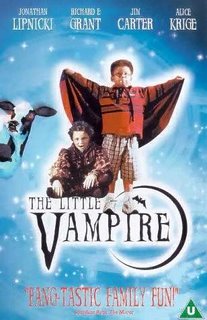
Release Date (2000)
Director: Uli Edel
Contains Spoilers
The film begins with a group of vampires performing a ritual on a cliff top. The ritual is interrupted by a vampire hunter, who tries to steal the stone from the amulet that is the centre of the ritual. The stone flies over the cliff edge, followed by a vampire. He plummets towards Tony Thompson (Jonathan Lipnicki), a young boy whose bed is floating in the sea. Tony is having a nightmare.
Tony is a young American boy, moved to Scotland whilst his father builds a golf course. He has no friends and is bullied, his despairing parents believe his obsession with vampires is a form of escapism.
Tony’s parents go to a ball, leaving Tony drawing pictures from his dream. He even makes himself a set of paper fangs.
Rudolph Sackville-Bagg (Rollo Weeks) is a vampire, when we first see him in bat form, being pursued by vampire hunter Rookery (Jim Carter). Injured by the sun lights from Rookery’s truck, Rudolph flies into Tony’s room having mistaken the dress up game for seeing another of his kind. Tony helps Rudolph by taking him to feed on nearby cows and they become friends.
The rest of the story is fairly basic. Rudolph and his family want to become mortal. This can happen through the ritual Tony dreamt of, at the time when the comet of lost souls passes the moon, with the use of the missing stone. Rookery wants the stone as he can use it to destroy all the vampires. They eventually discover that the stone is hidden in Tony’s room, hence the dreams he has been having. After several adventures they succeed in gaining the stone and it is Tony’s wish that lifts the vampire curse. The coda of the film sees Tony meeting the now mortal Sackville-Baggs.
This is, obviously, a kid’s film; based on a series of books by Angela Sommer-Bodenberg. As such the lead roles are played by child actors and this can, often, be problematic. However in “the Little Vampire” the kids do a good job. Lipnicki can be annoying, though he was obviously very young. That said Rollo Weeks and Anna Popplewell, as Rudolph’s overly romantic sister Anna, both are excellent.
Of the adult actors the stand-out performances are by Jim Carter as Rookery and Richard E. Grant as Frederick Sackville-Bagg, the head of the vampire clan. Grant was born to play a vampire and it would be marvellous to see him play one in an adult level film.
The film also contains some marvellous comedy moments. The vampires drink cow’s blood by choice and there is a recurring theme of a farmer attending his fields to see the number of his herd dwindling. He goes to the cow shed to discover those that have been bitten sheltering from the sun, their eyes glowing red and, eventually, roosting like bats. This running joke reaches its conclusion when the cows fly to Tony’s rescue at the climax of the movie, dive bombing Rookery’s truck and hitting the windshield with a well aimed cowpat. Incidentally the official website has a downloadable game in which you take the role of Rookery, blasting vampire cows with your sun lamp.
Equally amusing, though terribly under-used, is the cemetery’s caretaker, who is used as bait by Rookery and bitten by Gregory (Dean Cook), the rebellious oldest son of the vampires.
The film has its moments of action and does its best to build an atmosphere, though it is constrained due to the target audience. The very end is also incredibly “feel good”. That said if you fancy something undemanding or, like me, you have a son who wants to watch a film with vampires, this is worthwhile. 6.5 out of 10.
The imdb page is here.
Posted by
Taliesin_ttlg
at
7:36 AM
0
comments
![]()
Labels: vampire
Wednesday, March 22, 2006
Classic Literature: I am Legend
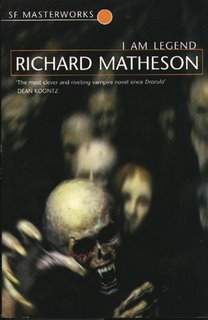
A grim vision of the end of humanity, this is possibly the best way to describe "I am Legend". Written by Richard Matheson and published in 1954 the book has proven very influential, though perhaps not in the way one might imagine.
It is centred around the character Robert Neville, the lone survivor of a deadly plague which has spread through the world. As more and more succumbed to the plague the horrific truth is discovered, those who die do not remain dead, they return hungry for blood. They are little more than killing machines, some memory but not much in the way of faculty.
Neville survives though his sanity is sorely tested. At night he is holed up in his boarded up house, taunted by the dead, especially by Ben Cortman his former neighbour. During the day he hunts them down, searching for their hiding spots, despatching them.
As the novel progresses we are given a fascinating look into Neville’s mind. He does not understand why he is the only one who has survived, he misses his wife and child – both victims of the plague, he is lonely.
He is an ordinary man forced to face extraordinary circumstances. He researches, searching for answers and here, as in many other ways, the book shines. This is a bacterium infection, there is nothing supernatural about it. The deterrents against the vampires all have a base in science. The fact that Matheson uses science causes the horror of the book to blossom, there is a reasoning beyond the supernatural and that makes the story all too real.
Yet Neville is not alone, there are infected people who have not died , that have learned to control the condition and who are rebuilding society. Yet many of these none-dead have been killed by Neville as he has hunted the dead, not knowing that they are living survivors. He meets Ruth, who manages to convince him that she escaped infection also. She is there only to spy on him, the man who murdered her husband, yet she develops feelings for him and, as he discovers that she is infected, tries to warn him of the danger.
In the end Neville is captured and the true genius of the book is revealed, for it is not the vampires who are the monsters, for they are now the norm. It is Neville who is the monster, for he is the only one who does not carry the infection, it is Neville who is the Legend.
The book has spawned two direct movie adaptations, the first being t he marvellous “the Last Man on Earth” (1964) starring Vincent Price. This is the closest adaptation so far and, beyond anything else, has the voice of Price used to great effect during the many voiceovers through the film. Sometimes it is accused of not being a vampire movie, I disagree. The film carries the elements that Matheson put in his novel well and makes a definite distinction between the shambling dead vampires and the well-functioning live vampires. “The Last Man on Earth” is public domain and available for free download from the archive.
he marvellous “the Last Man on Earth” (1964) starring Vincent Price. This is the closest adaptation so far and, beyond anything else, has the voice of Price used to great effect during the many voiceovers through the film. Sometimes it is accused of not being a vampire movie, I disagree. The film carries the elements that Matheson put in his novel well and makes a definite distinction between the shambling dead vampires and the well-functioning live vampires. “The Last Man on Earth” is public domain and available for free download from the archive.
The other obvious adaptation was “The Omega Man” (1971). This is certainly not a vampire movie, being a mutant movie. That said, in its turn it did inspire “The Homega Man”, from a Simpson’s Halloween special.
However, one of the biggest influences that the book has had is on another genre altogether. George Romero’s “Night of the Living Dead” (1968) owes a huge debt to “I am Legend”. Though Romero used zombies, with their taste for flesh rather than blood and their ability to walk in daylight, the influence of the novel shines through. Of course this film is the granddaddy of the zombie genre, and is itself available for download from the archive.
It is essential, also that I mention the graphic novel “I am Legend” by Steve Niles, illustrated by Elman Brown. This is a fantastic version of the novel, with stark pen and ink illustrations and is perfect to the source material.

Posted by
Taliesin_ttlg
at
11:06 AM
5
comments
![]()
Labels: classic literature, plague, vampire, zompire
Tuesday, March 21, 2006
Dark Days – Review

Written by: Steve Niles
Illustrated by: Ben Templesmith
Contains spoilers
This is the sequel to 30 days of night, and is altogether a more rounded piece. The novel starts where the last book ended and again we see the immolation of Eben Olemaun. Sixteen months later Stella leaves Barrow for LA, she has written a book, entitled 30 days of night, surrounding the events in Barrow. One immediately neat piece is that Stella's book has the cover of the first graphic novel.
She arrives in LA to do a talk regarding the book, but it has been read by the vampires – something she counted on as she has assembled and trained a team of hunters. The vampires react in different ways, one group deface the memorial of Eben and steal his ashes, they intend to resurrect him and kill him again in front of her, and others intend to simply hunt her down. Worse a mysterious ancient, known as Missus, the wife of Vicente, has been drawn from her Norwegian retreat to exact her revenge on the wife of the man who killed her husband.
Also drawn to Stella is Judith Ali, the mysterious woman from New Orleans from the first novel, who has the footage of the attack on Barrow, the footage her son sacrificed his life for.
As the novel progresses Stella meets Dane, a vampire sired by Marlowe. At first he wants revenge, but he discovers that it was not Eben who killed Marlowe, but Vicente. Stella discovers that perhaps not all the undead are as psychopathic as the ones that attacked Barrow.
The two are drawn to a confrontation with Missus.
The first thing to say is that there is so much more plot that the first book, it is well rounded and we gain an insight into the characters that the first book did not entertain. “Dark Days” realises the potential that “30 days of night” had but did not achieve. I have glossed over the plot, in this review, in a way that I did not do for the first novel because there is so much to discover and it is a joy to do so.
Characterisation has vastly improved. We learn to care about Stella and Judith and we are genuinely intrigued by the goings on amongst the undead, perhaps the characters and motives of the vampires are still a little vague, but it offers an air of mystery rather than making them feel like plot devices. A lot of the action is much more up close and personal than that of the first and the book is stronger for that. We also get some interesting glimpses into the mythology Niles is building. In the first novel it was intimated that a scratch from one of the undead would infect a mortal, now we discover that it might. We find that they can be resurrected by having blood poured upon their ashes. There are Renfield type characters called bug eaters, some of the undead can communicate telepathically and they can resurrect the dead as drones to battle for them.
Illustration wise, Templesmith’s work is very similar to that of the previous novel, the Lovecraftian air is still there but the movement from the frozen wastes of Alaska into the concrete jungle of LA seems to suit the style wonderfully.
If I had one complaint it was that the relationship which developed between Stella and Dane seemed to happen rather suddenly, but that almost fit in with the character of the new, reckless Stella.
Overall this is a commendable addition to the annals of vampire fiction and gains a worthy 8 out of 10.
Posted by
Taliesin_ttlg
at
10:14 AM
2
comments
![]()
Labels: vampire
An American Vampire in America

Just came across the site for this new film, definitely an independent though whether they're aiming for DVD distribution or putting it on the net I’m unclear of. In my “Vamp or Not?” piece, the rules of the game, I mentioned one category of vampire films – the believing you are a vampire category. This film certainly seems to fit into that.
The site has a teaser trailer on it, though what piqued my interest was the story and characters page, the page tells us:
Carl Weber, 26, was an ordinary college dropout and part-time grocery store stock clerk in small town America until he made a name for himself as a completely different kind of person: a vampire. Carl's bizarre claim was accompanied by an equally bizarre lawsuit:
Carl claimed that he should be allowed to work at night, despite the fact that his small town employer was only open during the day.
Now, this I found interesting and my mind went scurrying down the employment law line. We have a little piece of legislation in the UK called the “Disability Discrimination Act”. Now what if, as some movies depict, vampirism was a disease, could a company be expected to make reasonable adjustments to allow someone to work if they were a vampire?
Well to start off, the disease has to be a disability also and for that three criteria have to be met. It has to be a medically well recognized condition (okay we’re running on the premise that it is), the effects must last 12 months or longer (try eternity, my dear) and it must has a substantial effect on day to day activities (bursting into flames in the sun would certainly seem to qualify for that*)… Oh my… well, if nothing else this shows that my mind can work on some really bizarre levels.
As for the film, getting back to the point of the post, looks mighty interesting and has the potential to be a piece that could be truly politically and sociologically insightful. Whether it will meet that potential only time will tell.
*as an aside, I mentioned this to Ian, a friend of mine, who wondered whether the burning in the sun is actually SIC – spontaneous inhuman combustion.
Posted by
Taliesin_ttlg
at
7:43 AM
0
comments
![]()
You Can be the Slayer

I recently found a site online that I thought I’d share. Matt Shirley’s Vampire Killing Kits produce just that.
Unfortunately, none of the link buttons work, possibly because, according to the page, no fresh orders are being taken until January 2007, and as the kits are handmade that is understandable. Most definitely a present for the vampire fan who has everything.
Posted by
Taliesin_ttlg
at
7:34 AM
0
comments
![]()
Monday, March 20, 2006
30 Days of night - Review

Written by Steve Niles
Illustrated by Ben Templesmith
Published 2004
Contains spoilers
“30 Days of Night” is a graphic novel about to receive the big screen treatment. The setting is Barrow, Alaska and night is about to fall. But in Barrow when the sun sets it does not rise again for thirty days, hence the title.
For Sheriff Eben Olemaun and his deputy (and wife) Stella, sunset is the least of their worries. The communications station is having problems and someone has stolen all the mobile phones in the town and destroyed them. A stranger is arrested for disturbing the peace and, after taunting husband and wife, he bends the bars of his cell – only a bullet to the head seems to stop him.
Meanwhile, in New Orleans, a mysterious woman has had intercepted a series of e-mails which talk of a gathering in Barrow. She sends her son to gather the evidence they need.
In Barrow, things have gone to Hell for the vampires have come. For thirty days they need not sleep, the humans cannot escape nor call for help and they do not intend to leave any alive. Their leader, Roderick Marlowe, awaits the arrival of Vicente, an elder, to join in their fun. The last few remaining humans, including the Olemauns, are holed up in a cellar, hungry and scared but relatively safe as the vampires’ keen sense of smell has been dulled by the cold.
When Vicente arrives he quickly kills Marlowe, due to the fact that he has broken thousands of years of hiding, convincing the humans that vampires are a myth. The survivors are not safe, however, Vicente wants Barrow wiped off the map, a mystery that will never be solved.
The arrival of a helicopter, flown by the son from New Orleans, provides the cover story Vicente needs. He runs the side of a building and launches himself at the aircraft. Just before he dies and the helicopter plummets to the ground, the son presses send, transmitting the footage he had filmed to his mother. The fireball from the crash will be the cover story that the vampires will use for the destruction of Barrow.
In the cellar, one of the survivors has been scratched by a vampire whilst searching for his girlfriend. He made it back to the other survivors, but he begins to change. Eben and Stella manage to destroy him, by removing his head, but before they do Eben also manages to draw some of the infected blood. Eben has decided that if anyone is too survive they must fight fire with fire. He injects himself with vampire blood. Changed forever he turns his back on his fellow survivors, with an effort, and goes to face the undead.
With an effort he manages to destroy Vicente, running the undead out of town. With even more of an effort he manages to maintain his control long enough to sit, a couple of days later, and watch the sun come up with his wife – reducing him to ashes.
The plot is simple, but effective; unfortunately the novel is fundamentally flawed. What we have here is a survival horror – with vampires – but no real survival story. The actual story only covers some 78 pages. There is an excellent build up, but the passage of time between the initial attack and the climax is glossed over so quickly that you actually almost miss that nearly 28 days have passed. A few more pages of the survivors’ struggle would have helped, as would a reflection in the artwork. The male survivors would not have shaved but Eben only goes from clean shaven to light stubble. We do see Eben on one forage, but perhaps we should have seen the injured survivor who turns hunting for his missing girlfriend, it would have helped.
There is also a frustrating lack of characterisation; we would feel more for these characters if we knew more of them. As it is, with the partial exception of the Olemauns, the characters feel like little more than plot devices.
The artwork has seen some divided opinions between my friends, but I like Templesmith’s style and the whole thing is very cinematic. The beginning with husband and wife watching the sunset going through to the end with them together before the sunrise is beautifully circular. The vampires, to me, have an almost Lovecraftian quality with their exaggerated mouths filled with razor sharp teeth and lolling tongues.
What we have here is a brilliant idea that feels rushed, and the sequel, “Dark Days”, is superior for being much better rounded. This will, I hope, make an excellent movie but the film makers do need to ensure that the passage of time is more fully realised and expand on the characters. I will give this 6 out of 10, above average but losing marks for the flaws – which is a real shame.
Posted by
Taliesin_ttlg
at
10:13 AM
3
comments
![]()
Labels: vampire
Classic Literature: Carmilla
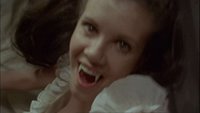
More often than not, I will cite “Dracula” by Bram Stoker as a key piece of vampire literature. The reasoning is obvious, the book has never been out of print since its publication in 1897 and there are very few people that have not heard of the character, even if they haven’t read Stoker’s seminal work. A quick search on imdb shows over 140 movies with a full or partial name match to Dracula, not to mention those other movies directly linked to the book and/or character.
Another, less well known vampire story was by another Irishman, Sheridan Le Fanu and his story “Carmilla”, which was first published in 1871 as a serial in the Dark Blue and then complete in 1872, has had a defining effect on the genre also. It is clear that Stoker was aware of “Carmilla”. Le Fanu’s story is set in the country of Styria and, in an early manuscript, “Dracula” was also destined to be set there, until Stoker changed location to Transylvania. The deleted first chapter (according to Florence Stoker) of “Dracula”, “Dracula’s Guest” is still set in Styria.
Spoilers ahead:
In Le Fanu’s novella, a wealthy English widower retires to Styria with his daughter Laura. Laura awaits the arrival of a friend when General Speilsdorf, her friend’s father, sends a letter to say that his daughter has died.
There is then a carriage accident outside their home. Carmilla, the young passenger, is uninjured but her mother informs Laura’s father that she is on urgent business and cannot be delayed, thus arranges for Carmilla to stay with the family.
Carmilla is, of course, a vampire, and takes both a predatory and romantic interest in Laura – a brave move by the author considering when the story was written.
As Laura’s health declines so we discover some of the “rules” LeFanu introduces for his vampire. She sleeps often through the day, she is enraged by the singing of Christian hymns, she can pass through walls and takes the form of a monstrous black cat.
We eventually discover that the General’s daughter was killed by Millarca, Carmilla under an anagrammed pseudonym and the source of many film makers using the anagram of Alucard for Dracula, and they go to find Carmilla’s tomb. The tomb is that of the Countess Mircalla Karnstein and Carmilla is disposed of by staking through the heart, cutting off the head, burning the remains and scattering the ashes in a river.
Amongst the movies Carmilla inspired are a trio of Hammer productions “The Vampire Lovers” (1970), “Lust for a Vampire” (1970) and “Twins of Evil” (1971), the latter being the source of the still at the head of this piece. You can find the novella itself through Project Gutenburg and it is well worth a read.
Posted by
Taliesin_ttlg
at
7:21 AM
17
comments
![]()
Labels: Carmilla, cat vampire, classic literature, vampire
Sunday, March 19, 2006
More Blade

The site Comic book resources has more on the new Blade TV series. To me, most interesting was the thought that the show intends to look into the mythology, including such things as how Blade got his tattoos. Now this is something that bothered me in the movies - Blade is part vampire, he has all their strengths, which has to include regeneration, tattoos are essentially a scar containing ink... You can see how my mind was working, so what's the story, ink laced with either traces of silver or garlic essence? Perhaps we'll find out.
Posted by
Taliesin_ttlg
at
10:17 PM
0
comments
![]()
Brotherhood of Blood
 Another new vampire movie, "Brotherhood of Blood" is in post production.
Another new vampire movie, "Brotherhood of Blood" is in post production.
It stars Victoria Pratt (pictured) and Jason Connery as vampire hunters who capture a vampire (Ken Foree), torturing him to gather information on a captured colleague. Further details are sketchy but there are a couple of good screenshots over at the horror channel's dread central. The movie does have its own homepage, but so far it is just a placeholder.
Posted by
Taliesin_ttlg
at
2:31 PM
0
comments
![]()
Project Vampire – review

Release Date: 1993
Director: Peter Flynn
contains spoilers
When I’ve written my previous reviews I have either just watched the film for the first time, or I’ve decided I wanted to write a review of a particular film, dug out the DVD and re-watched the movie, both out of the enjoyment I gain from watching vampire movies and because I want the film to be fresh in my mind.
Now, I decided to write a review of “Project Vampire”, not because it is a great film but because it is an awful film. Unfortunately, so bad is the film that I couldn’t actually bring myself to re-watch it. Therefore this review is reliant upon memory and a mini customer review I wrote for Amazon.
“Project Vampire” is missing one or two elements from it, such as a script, actors and any form of logic.
The film is concerned with Project Alpha. At the start of the film we have three “escapees” from the project running down the street, being chased by a car, and it was here that I lost the will to live. The men do not do anything that would be logical in the situation. They don’t steal a car, get a bus or flag down a cab. They are wearing lab coats, thus stick out like sore thumbs, but do they take them off? Oh no, that would be too sensible. At one point they have nipped out of sight of their pursuers and go past a hotel, and they don’t think to hide inside. Yet still it takes time to be caught (note to self cars can go very fast, pedestrians can’t, when chased by car be sure to run away…)
Let us look at their pursuers for a second. One is a vampire – he’s the one that looks evil and is bald, ooh and don’t forget that he wears leather. The other is an evil human, of course he is; he has a limp and an eye-patch. The stereotypes aren’t even fun because the film takes it self altogether too seriously.
The car does finally catch them but eventually one of the escapees, Victor Hunter (Brian Knudson) gets away and is found by a nurse, Sandra Jensen (Mary Louise Gemmill). She, of course, gets drawn into the… I was going to say plot but that would be an exaggeration. So what is the… darn, I can’t say plot… flimsy premise of a story? Evil vampire Dr Frederick Klaus (Myron Natwick) is going to put a longevity drug on the market; this is what Project Alpha is producing. The drug is made from Klaus’ vital fluids and rather than give “longevity”, as the consumers would imagine, it will turn everyone in the world into vampires under his control. Serious plot flaw here, everyone is a vampire, so what are you going to feed on Dr. Klaus?
That’s about the top and bottom of it, Hunter has been injected with the drug, as you would have already guessed. Hunter eventually succeeds in defeating Klaus and saving the world… unfortunately, by that point, I had given up the will to live and was only watching the film because I had parted with good money for the DVD.
There was a moment that resonated with me; at one point Nurse Jensen declares “Victor, this is so unbelievable.” With that I agreed. The characters, however, seemed to believe the ridiculous story at the drop of a hat.
The film is poor and, believe me, I genuinely like some really bad vampire movies - at some point I will review “Killer Barbys” (1996) and know I can find lots of things to like, even within that. The problem is that “Killer Barbys” does have a certain something, a charm that is hard to pinpoint, but is there all the same, “Project Vampire” lacks that charm. Other vampire movies might have unbelievable moments but they have already managed to get you to suspend your disbelief, and others still rely on fast action that makes you take your brain out and just enjoy. “Project Vampire” fails to do anything that could make you enjoy it.
I’m giving “Project Vampire” 1 out of 10, it would probably have been zero but something tells me that there is even worse out there. Brutal, perhaps, but I think fair.
The imdb page is here.
Posted by
Taliesin_ttlg
at
7:38 AM
0
comments
![]()
Labels: vampire
The School Marm Vampire; machinima

For those who haven’t come across machinima yet, machinima is the art of making films using game engines. At first glance this might seem restrictive. Certainly with games such as the Movies, which as well as being a tycoon game is also an active encourager of machinima productions, it can be – the film maker is constrained by the locations, skins and animations within the game’s engine.
Where there is a will, however, there is a way, and there are a lot of creative machinima’s being developed. One such series is “the School Marm Vampire” by Blind Watcher Productions, currently up to part two, with part three in development. The series is made using the Sims 2 engine.
The synopsis, from the homepage, of the two episodes are as follows:
Part 1 - Blind Watcher Productions proudly presents: The School Marm Vampire, expect only the unexpected as we take you through a bizarre story that will slowly unravel throughout its episodes. Christine, Danielle, and Eric sit down to their first class of Eastern European Folklore 101 and who should be their instructor, but an old bat of a woman, who loads them with homework. They turn to the autistic genius, George for help... but something goes wrong...
Part 2 - Part two of our new series, The School Marm Vampire continues when Eric, Christine, and Michelle all get As on their papers (that George wrote for them), and the School Marm, astounded by their unlikely brilliance asks them to meet her in her office to discuss an artifact which they all had mentioned in their papers. The three know they're in trouble, and seek the artifact before their meeting with Madam Icabod so that they can show it to George... Is George REALLY WHO HE SEEMS SO BE?
Both parts are available in wmv, and also in i-pod compatible format. The homepage is here.
Posted by
Taliesin_ttlg
at
2:33 AM
3
comments
![]()
Saturday, March 18, 2006
Vamp or not? The rules of the game.

Rather than look at a specific movie, I thought it apt to have a look at some of the “rules” used to determine whether a movie is a vampire movie or not. The more we look at this, the more inconsistency we find, so this little foray into the “rules” carries two guarantees; firstly there are no definitive answers here and, secondly, there are going to be aspects and indicators missed.
Fangs: Oft quoted but not necessarily always used in vampire movies. Certainly there are no fangs in either The Hunger (1983) or “Near Dark” (1987) yet they are both, most definitely, vampire movies. Other film have alternative methods of feeding, such as the barbed proboscis that emerges from the armpit in “Rabid” (1977) a film often listed as a vampire movie. That said, fangs are often a good indicator.
Changing shape: There are, unfortunately, many supernat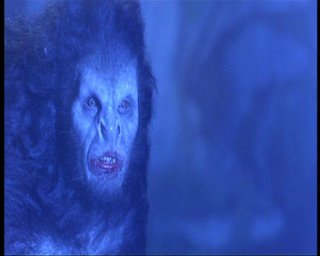 ural creatures which can change shape. The vampire’s ability to become wolfen, as in the still from “Bram Stoker’s Dracula” (1992), often clashes with the werewolf genre, but this should be of no surprise as the werewolf and vampire myths are closely linked in certain parts of the world. Less common, however, is the ability to become mist and almost always exclusive to the vampire genre is the ability to become a bat.
ural creatures which can change shape. The vampire’s ability to become wolfen, as in the still from “Bram Stoker’s Dracula” (1992), often clashes with the werewolf genre, but this should be of no surprise as the werewolf and vampire myths are closely linked in certain parts of the world. Less common, however, is the ability to become mist and almost always exclusive to the vampire genre is the ability to become a bat.
Drinking blood and other sorces of nutrition: A difficult one. Blood drinking seems to be a pre-requisite, but sometimes other feeding patterns emerge. This can include flesh eating, which, whilst similar to the zombie genre, is legitimate within the vampire genre as some vampire legends had flesh eating as part of the modus operandi. Psychic vampirism may come into a film, as could wholesale sucking the life force from a victim, the film “Lifeforce” (1986) being a prime example of this. On the other hand a film might have a creature obsessed with blood who is not a vampire. Is it simple enough to break this down and suggest that a vampire can be any form of parasite? Not really. Blood drinking is a good indicator, however.
Holy symbols, garlic and stakes etc: This one is really a toughie. Firstly the symbols and items also affect other creatures – so a cross would affect a demon or silver would affect a werewolf, and let’s face it a stake in the heart will kill a mortal as quickly as it would kill the undead. Also film makers twist the rules as they want. In the “Lost Boys” (1987), as an example, not only does garlic not work but the rule is invented that all the devices and items are rendered useless if the vampire is invited inside.
The Walking Dead: This is a real area of confusion. Certainly there are similes between the zombie and the vampire, No more so than in “The Living Dead Girl” (1982) which is a real hybrid of the two genres. My rule of thumb has always tended to be that if the returned dead is cognizant, preferably with memory, then it is more likely to be a vampire rather than a zombie. Other aspects to consider here is that the vampire tends to be a creature filled with lust were the zombie does not and the vampire can regenerate whereas the zombie rots. These basic premises do not always work, however, and there are also a myriad other forms of the walking dead.
Running water: Little used, but part of the genre, is the vampire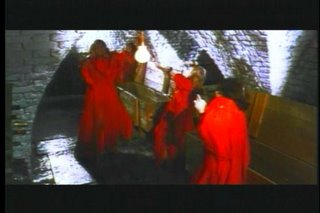 ’s aversion to running water. Le Fanu uses this devise in "Carmilla as does Stephen King, at least in passing, in “’Salem’s Lot”. Hammer fell back on this one a couple of times and the illustrative screen shot is from “the Satanic Rites of Dracula” (1973) as the "brides" are doused in water from a sprinkler.
’s aversion to running water. Le Fanu uses this devise in "Carmilla as does Stephen King, at least in passing, in “’Salem’s Lot”. Hammer fell back on this one a couple of times and the illustrative screen shot is from “the Satanic Rites of Dracula” (1973) as the "brides" are doused in water from a sprinkler.
Sunlight: Again this is another difficult one. Whilst many films and books have the vampire tied to the night, many others do not. Bram Stoker allowed Dracula access to the daylight, also in “Two Orphan Vampires” (1995) the vampires are fully able to walk in daylight, though they are rendered blind. Burning in sunlight can, however, be a good indicator.
The Demon Aspect: Is it a vampire or is it a demon? The answer to that question was certainly blurred by “Buffy the Vampire Slayer” as the vampires are a certain type of demon which has taken residence in a body. Often the incubus and the succubus are classed as vampires, though these demons are sexual in nature rather than blood drinkers.
Alien visitation: Quite a popular one from time to time. “Lifeforce” (1986) was certainly about alien creatures and the marvellous “Goke: Body snatcher from Hell” (1966) involved a human possessed by an alien creature. Hey, even Buck Rogers faced a space vampire. It can be, it seems, that your vampire can be an alien rather than a supernatural creature.
Supernatural or natural/science based: By this I mean either another race of creatures, called vampire, from Earth or vampires created by science. The second is most definitely popular. Currently we have a rash of films that cite retro-virus or genetic tampering, but even in the 50’s mad scientists were creating vampires in movies – Blood of Dracula (1957) for instance. Both this section and the one before just go to show that your vampire doesn’t have to be what we would think of as undead.
Creating others: This was a rule of thumb that I used when deciding that Lair of the White Worm (1988) was a vampire movie, but it is not always the best rule of thumb as many creatures from horror movies can create others of their kind, and both the werewolf and zombie often do this through their bite. It is also clear that if a bite is enough, or whether a transfer of energy or blood is needed, changes from film to film.
Pretending to be a vampire: This is one where certain films fall into the genre without having a vampire in the film. One prime example is “Mark of the Vampire” (1935) in which the vampires are actors. “Sherlock Holmes and the Case of the Sussex Vampire” by Sir Arthur Conan Doyle is another example but its screen version, “Sherlock Holmes and the Last Vampire” (1992), could well fall into the next category.
Believing you are a vampire: Slightly different and easier to  class as a vampire movie then one in which the protagonist simply pretends to be a vampire. Here we have such films as the very black comedy “Vampire’s Kiss” (1989) a film that leads to the marvellous scene, pictured, of Nicholas Cage wearing cheap fake fangs, as he convinces himself that he has been infected with vampirism.
class as a vampire movie then one in which the protagonist simply pretends to be a vampire. Here we have such films as the very black comedy “Vampire’s Kiss” (1989) a film that leads to the marvellous scene, pictured, of Nicholas Cage wearing cheap fake fangs, as he convinces himself that he has been infected with vampirism.
Village Hysteria: Sometimes it is not necessary to have someone pretending to be a vampire or even believing themselves to be one. A film such as “Isle of the Dead” (1945) is most definitely a vampire movie, though there is not a single vampire in it. This movie relies on the hysteria that, in the past, probably gave birth to the legends of vampire outbreaks.
But the book was about a vampire: Just because the source material was about vampires does not mean that the film is. A classic example of this is Richard Matheson’s “I am Legend”. Personally I would class “The last man on Earth” (1964) as a vampire movie, and this was based on the book, but so was “The Omega Man” 1971) and “Night of the Living Dead” (1968), neither of which are of the genre in my opinion.
But the title indicates it is a vampire movie: This is the worst reasoning for whether a film is of the vampire genre or not as there are some really misleading titles. Some films have multiple names, so “The Devil’s Nightmare” (1971) is also known as “Vampire Playgirls”, but you won’t find a single vampire. “Bloodsucker leads the Dance” (1975) is equally misleading, being a murder mystery within an almost psychedelic gothic framework, but again no vampires.
Posted by
Taliesin_ttlg
at
2:39 PM
9
comments
![]()
Friday, March 17, 2006
Blade the Series
Thanks to the comment from Mateo, on an earlier post, I have been off searching and found an online trailer for the tv series of Blade.
Many thanks for alerting me that the trailer was about. It's only a teaser, but there seems a good chance that they are not going to kill the franchise.
Posted by
Taliesin_ttlg
at
4:22 PM
1 comments
![]()
Night Fangs – Review

Release date: 2005
Director: Ricardo Islas
contains spoilers
Night Fangs is a low budget, English language movie from Uruguay. The back of the DVD box claims it to be “the goriest and most horrifying vampire movie ever.” Well, not really, I would say that the credit for that has to go to “Strange things Happen at Sundown” (2003). But gore is not what makes a film and this little gem has a lot going for it and a lot of plot crammed into it.
The film starts with two women, Jennifer Sommers (Leslie Frank) and Lupe (Cyn Dulay) picking up a guy, Mike, over the internet. They meet him and take him home, where they, whilst he is handcuffed, inform him that they are thugees and strangle him. This is an interesting aspect to the film in the first instance. The thugees were a cult dating back to the 13th century, and worshipped the Hindu Goddess Kali. They believed that each murder they committed prevented Kali’s return for 1000 years but we must remember that Kali is often depicted drinking blood – which creates a nice vampire connection.
We next see the girls in a bath, the blood from their victim’s now cut neck trickling into the water. The film next establishes that Jennifer is a pottery teacher and she and Lupe are openly lesbian. They are expecting a package containing Elizabeth Bathory’s diary and Lupe picks the courier up at an airport. However, on the drive back his taunts over her lesbianism cause her to attack and kill him, the fury she demonstrates showing just how psychotic she is.
The diary is not in English so they approach Professor Nashy (played by the director, Ricardo Islas), the history teacher, to translate. Now Bathory did, historically, keep a diary of her crimes. In the film the diary reveals that Bathory was also a member of the thugee cult, converted by her brother when he returned form the crusades – not too much of a stretch, actually, as some parts of the cult traced their roots to early Muslim kings and the Bathory family were certainly involved in the war with the Turks. The diary also reveals that Bathory’s blood ritual needs virgin blood. Cue the teachers hunting for a virgin student, their attention focused on Amy (Ruby Gonzalez).
In the meantime Nashy (one wonders if the character’s name was a tribute to horror legend Paul Naschy) is having visionary dreams of Bathory and vampires.
Jennifer seduces Amy, trying to ascertain if the girl is a virgin. They are watched in secret by Lupe, her palpable anger showing us again how deranged the woman is. Amy confesses her virginity and Lupe attacks the girl, leaving Jennifer clearly distraught. Later in the film Jennifer confesses her doubts about the road they have taken and Lupe explains that they will succeed and become vampires or she will kill Jennifer and then commit suicide.
Meanwhile Amy’s boyfriend Steve (Mark Edwards) has met up with friends. One realises that he knows the teachers’ earlier victim and an e-mail leads them to suspect the teachers. They go off to rescue Amy.
Lupe slits Amy’s throat and the two women bathe in her blood, but to little effect. To test whether they are vampires, Lupe attacks Jennifer. The teacher defends herself and cracks Lupe’s skull on the bath, running from the bathroom in panic. The blood spills into the already bloody bath water, which contains Amy’s corpse and it is she who becomes vampire. The two teachers are quickly turned. The way the vampires are done in the film is very effective. They are animalistic, drool as their fangs are extended and growl like big cats. They are also flesh eaters as well as blood drinkers.
There follows an attack on Amy’s friends as the vampires find their feet. The director produces a decent level of tension, despite the old horror cliché of splitting up when entering the bad guys’ lair. There is also an effective wall climb and attack.
The night ends with three survivors, including Steve who has been bitten and is changing. The two friends leave Steve and go to find Nashy and, unusually for such films, he does take some persuading. He also has some great lines, for instance “After 100 years of movies, Stephen King, Anne Rice and Buffy you still need a Professor to tell you what to do!” Another good one was “What do you want from me? I’m just a history teacher. I’m not Agent Mulder.”
They discover that sunlight cures Steve and then batten down the hatches for an expected night assault. The assault is languid in pace, with slow thunder sounds, but this pace seems to work. The next day they track down the vampires and here we confront a potential logic problem. We are left with Nashy, Steve and his friend. Nashy is the only one not bitten and sunlight is a cure, but then sunlight kills the vampires.
Perhaps it is within the downbeat ending, when all is lost and only Steve remains for a vampiric Nashy to attack that we gain a semblance of an answer. Steve had not died from his attack, thus sunlight was able to cure him. It seems that it is the ones that have died and returned that are affected by the sun in a deadly way. This is not explained explicitly.
Some of the acting is average, but others in the film shine and this shows what can be done with a low budget. There are elements in the film that need expansion, such as Nashy’s visions, but overall this is an interesting and intelligent film and I’ll give it 6.5 out of 10.
The imdb page is here.
Posted by
Taliesin_ttlg
at
3:46 PM
2
comments
![]()
Labels: Erzsébet Báthory, vampire
Thursday, March 16, 2006
Blood Ties
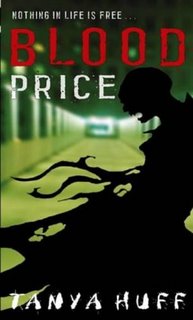
Canada's CHUM television has commissioned a 22 episode series Blood Ties, based on the Tanya Huff novels.
From the press release:
Blood Ties is based on Tanya Huff's internationally popular "Blood" novels. When her latest love interest turns out to be a 450-year-old vampire and the caseload of her fledgling P.I. agency shifts from fraud artists and cheating spouses to battles with ghosts, ghouls, zombies and demons, ex-police detective Vicki Nelson realizes that her life will never be the same. The series will be produced by Kaleidoscope Entertainment and goes into production later this summer.
Having read the series, I can say that the books are excellent and, so long as they don't kill the books, it'll be great to have a new vampire based series.
Posted by
Taliesin_ttlg
at
11:22 PM
2
comments
![]()
Jesus Christ Vampire Hunter – review
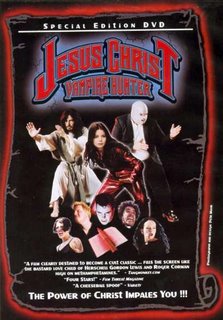
Release Date: 2001
Director: Lee Gordon Demarbre
Contains Spoilers
The first thing to say about this movie is that it is a fun, amusing flick that – despite what you might think by the title – I can’t see giving, in any way, offence to Christians. In fact the way Christ is portrayed is in a very positive light and, given the role that Christian Iconography plays in the vampire genre, it seems only logical that someone would take the next step and pit Christ himself against the undead. The film itself is a no-budget, kung fu movie with vampires and lesbians.
The premise sees daywalking vampires preying on lesbians and the church calls in the one man who can save them from the undead, Jesus Christ (Phil Caracas). The reason that the vampires are hunting lesbians is to allow a mad scientist (Josh Grace) to steal their skin, grafting it onto the vampires so they can walk in daylight. Why choose that section of society? As far as the vampires are concerned they are deviant and won’t be missed. Jesus’ retort, “There’s nothing deviant about love.”
The fight scenes in the film are almost laughable, but come across as so batman circa the 60s that they have a charm to them that is almost palpable – despite a high level of violence and gore, including the use of intestines as nun-chakas.
The film has some marvelous concepts and visuals as well. At the head of the film, chief vampiress Maxine Shreck (Murielle Varhelyi) feeds upon a nurse. She then steals the nurse’s car, stepping over the prone body. From the car she leans across, wipes some blood from her victim and then licks it from her finger. The imagery portrayed at that moment is actually quite powerful.
A further scene with Shreck in it that was excellently shot was when she fed upon Jesus’ sidekick, Mary Magnum (Maria Moulton). The visual just seemed to work so well.
One stand out moment occurs during a mass fight in a jazz club, that seemed almost as though we had stepped into a low budget, non-slick “From Dusk ‘til Dawn” (1995). Within this scene we get the first ever vampire staking, that I am aware of, by someone sat on a toilet with their trousers around their ankles!
In the film we hear that vampirism is a quantum infection, taking the form of a virus, bacteria or fungal infection dependant on the observer. We are then told that as light is both waves and particles, perhaps this is why vampires don’t reflect. It’s complete technobabble, but somehow it works.
There are some logical problems with the movie, though I guess I’d have been shocked if there wasn’t. I kept thinking, as I watched, about the iconography of the cross and if the symbol of Christ on the cross is so painful to vampires then how can they stand being near Jesus himself. Then, in a pure low grade Van Helsing moment, Jesus pulls two windscreen wipers from a derelict car and crosses them to ward of chief vampire, Johnny Golgotha (Ian Driscoll). Now Golgotha does, eventually, pull the cross from his hands, but surely the presence of the man himself would have been enough. Yet the climax of the movie sees Jesus impaled through the chest by his own stake, which, when removed, causes a vampire slaying light to pour forth – the divine essence of Christ is within him and not without. Jesus then resurrects some of the vampires, but in their human form and seems, himself, none the worse for his brush with the stake.
Incidentally, did I mention that it’s a musical and has a rather large built “saint” in a wrestling mask! Oh I also forgot to mention that the film is probably the first vampire movie to feature holy beer rather than holy water.
I watched this movie with low expectations. I expected low budget and awful effects, I didn’t expect to see iconic scenes buried within the movie, nor did I expect to enjoy it even a quarter as much as I did. With the caveat that this has no budget what-so-ever, and some of the worst voice looping I’ve seen for a while, I’ll happily give this 7 out of 10 as the actual content of the film drags it above the concerns born of zero budget.
The imdb page is here.
Posted by
Taliesin_ttlg
at
10:05 AM
1 comments
![]()
Labels: vampire
Wednesday, March 15, 2006
Dracula - Dead and Loving it – review
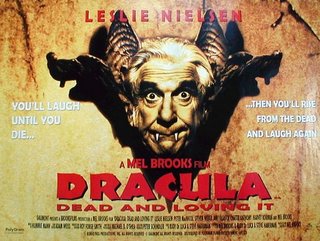
Director: Mel Brooks
Release Date: 1995
contains spoilers
Sometimes, amongst all the darkness and the blood, you just need to laugh. “Dracula – Dead and Loving It” is capable of providing such laughter. In many respects it is a typical Mel Brooks movie, though, even if you are not a fan of Brooks' work, if you are a fan of the vampire genre you may find much to tickle your funny bone.
I seemed to remember that this was much maligned by the critics when it was released and a quick look at the “rotten Tomatoes” site confirmed that, the film scoring just 4%. This, I feel, is unjustly harsh.
The film came out three years after “Bram Stoker’s Dracula” and drew certain similes with that movie. The movie poster certainly aped the early films promotional material, and such things as Dracula’s (Leslie Nielsen) funky hair – in this film actually a bizarre hat - and the actions of the shadow being independent to the Count were certainly spoofed from Coppola’s vision. However the majority of the film warmly spoofs Universals 1931 “Dracula”, from Dracula’s evening wear down to the very elements of the plot. It is this comedic tribute to the ’31 film that makes the film so enjoyable.
As for the plot, it is probably a useless exercise going through it point by point as it is so well known. It is more pertinent to focus on some of the set pieces, gags and performances.
One of the stand out scenes, that comes early in the film, is Renfield (Peter MacNicol) being accosted by the voluptuous vampire brides. (Bear in mind that in the ’31 plot it is Renfield and not Harker who travels to Transylvania.) In this scene the brides have been cut down from three to two and they glide into Renfield’s room as ethereal music plays. The main joke comes as Dracula orders the brides from the room, out they glide, once again accompanied by ethereal music. “Stop that!” orders the Count, the music stops and the brides stomp through the door.
Lucy is played by Lysette Anthony and Mina played by Amy Yasbeck. Both play the proper English woman well, and, in true Hammer style, after being bitten by the Count both become wanton. Harker (Steven Weber) is wonderfully dense and his stiff upper lip is something to behold. When the undead Lucy comes on to him, he cries “Please, Lucy! I’m British!”. “So are these,” drawls the vampiress, drawing his horrified attention to her heaving bosom. As for Dr Seward (Harvey Korman), well suffice it to say that he is obsessed with giving his patients enemas.
However, two of the best performances come from Nielsen as Dracula and Brooks as Van Helsing, both comedy veterans. In the film Van Helsing offers a truly unique (within the vampire genre) method of disposing of a vampire, “…cut off her head, stuff her mouth with garlic and tear off her ears.”
Unlike the ’31 film, Van Helsing does not spot that Dracula casts no reflection in a small hand mirror, in this film the mirror is huge and at a ball. This leads to a scene of Dracula and Mina dancing, yet in the mirror Mina dances alone. Of course this is scene is not unique but Harker’s comment is a pearl, “She's doing quite well without him, isn't she?”
The best performance, by far, is that given by MacNicol as Renfield, manic at times, barely refined at others, the performance owes much to Dwight Frye’s performance in the ’31 film and yet stretches beyond that in a wonderfully slapstick way.
“Dracula – Dead and Loving It” is not the only vampire comedy on the market, and it is not necessarily my favorite. However, I do have a real fondness for it and think it deserves seven out of ten.
The imdb is here.
Posted by
Taliesin_ttlg
at
3:02 PM
6
comments
![]()
Tuesday, March 14, 2006
Vamp or not? – Viy (1967)
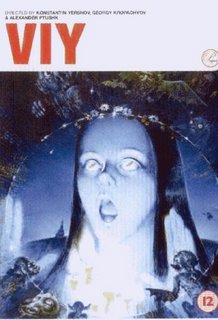 “Viy” was a movie produced in Russia in 1967. It is actually one of two films (so far) based on the Story “Viy” by Nicolai Gogol. The second film based on the story is “Le Masque Du Demon” (1960), staring Barbara Steele, which is definitely a vampire movie.
“Viy” was a movie produced in Russia in 1967. It is actually one of two films (so far) based on the Story “Viy” by Nicolai Gogol. The second film based on the story is “Le Masque Du Demon” (1960), staring Barbara Steele, which is definitely a vampire movie.
The Russian film is a visual treat, especially given when it was made. Three seminarians are travelling and ask for shelter in a farmhouse, their request is answered by an old woman. They are split up and, in the night, Khoma Brutus (Leonid Kuravlyov) has a yoke placed around his neck and is “hagridden” . He manages to kill the witch, who becomes a beautiful young girl, and returns to the monastery. He is then summoned to the abbot, as he has been requested by a prominent citizen to attend his dying daughter.
On, reluctantly, arriving at the citizen’s home Khoma discovers that the daughter has died and is told to sit vigil over her coffin for three nights praying. He, however, has recognised her as the witch become young.
Unable to leave he sits vigil. On the first night he begins to talk to the corpse when a tear comes from her eye, as it runs down her cheek it turns to blood. He begins to light candles but they are blown out, so he tries again successfully having blessed the candles. Then, as he prays, and takes sn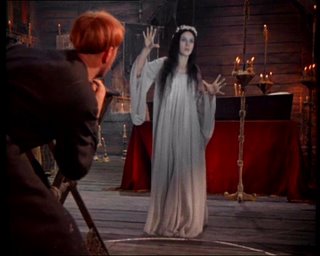 uff, the corpse awakens. The girl herself is physically a pure gothic picture of the vampire, but her movements are jerky and she gropes blindly towards him. The seminarian draws a sacred circle around himself in chalk; she cannot cross the circle and traces its edge angrily. Day breaks and she is pulled back to her coffin and the lid slams shut.
uff, the corpse awakens. The girl herself is physically a pure gothic picture of the vampire, but her movements are jerky and she gropes blindly towards him. The seminarian draws a sacred circle around himself in chalk; she cannot cross the circle and traces its edge angrily. Day breaks and she is pulled back to her coffin and the lid slams shut.
The next night he draws the circle as soon as he enters the church. After a while the coffin begins to levitate and ram into the circle’s invisible wall. The lid flies off and the girl sits up, and then stands, as the coffin flies and she calls out his name. The cock crows and the coffin returns to its place of rest, as it does the girl curses Khoma and his hair turns white as per the curse.
Again, on the third night, he draws the circle. The girl awakens and begins to curse Khorma immediately. Hands of greying flesh appear, and a skeleton walks followed by many forms of monsters and demons. She summons forth vampires and werewolves and then she summons Viy, the king of the underworld. A cock crows and Khoma makes the mistake of looking Viy in the eyes, allowing Viy to see him and rendering his circle useless. The minions of Hell descend on the seminarian. As the second cock crow sounds they abandon him, dead upon the floor, as the girl is pulled back to her coffin and transforms back into the witch.
At first glance this does not look very vampiric, but – though I have not read it myself – I have it on good authority that the Gogol story is about a vampire witch and that, other than this, the film is fairly faithful to the story.
The film ties in with Romanian Mythology. The strigoï are the evil souls of the dead that rise to torment the living, and are one of the bases of the modern vampire myth. There are two forms, the strigoï mort is a dead, or should I say undead, vampire. However the strigoï vii is a living vampiric witch. The strigoï vii will invade the dreams of children and ride them through their nightmares, this is commonly known as being hagridden and is a form of psychic vampirism. On death, the strigoï vii will become the strigoï mort.
The film “Viy” does contain summoned vampires, but it is not clear that the girl/witch is this strigoï vii become strigoï mort. However it does contain many elements which are vampiric in nature. I have listed the DVD in my vampire collection (though it is not an obvious genre movie and many may disagree with its inclusion) and think it a beautiful and extraordinary piece of cinema.
The imdb page is here.
Posted by
Taliesin_ttlg
at
2:00 PM
16
comments
![]()
Labels: strigoï mort, strigoï vii
Monday, March 13, 2006
Nightwatch – in 2.5 minutes
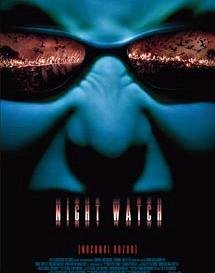
“Nightwatch” (or “Nochnoj Dozor”) caused much debate amongst my friends and I. One friend bought the Russian DVD and hated it, though I’m guessing that had much to do with the subtitles – the translations may have been too literal.
I saw the film at the cinema and thoroughly enjoyed it, loved the way the subtitles in the proper UK/US release were done and can’t wait for the DVD to come out over here.
Anyway, off I went to the Nightwatch site, just to have a look-see if it had anything on there about “Daywatch” (part two of the trilogy). Unfortunately not, but they have a new feature since last I looked – the movie available to watch (in a flash page), condensed to 2.5 minutes. So nip over there, strap yourselves down and get ready for a rollercoaster ride.
Posted by
Taliesin_ttlg
at
10:11 PM
2
comments
![]()
Synchronicity
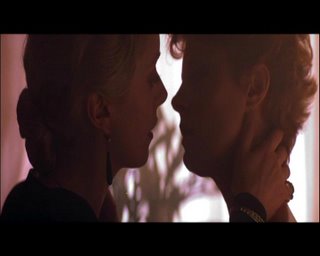
I decided to re-watch “The Hunger” and review it for the blog, having done so I was having a quick surf before uploading and came across a news piece concerning the 10 sexiest movie scenes.
Not only had a vampire movie made the top ten (at number 10), but it was the love scene between Deneuve and Sarandon from "The Hunger".
The full list can be found here.
Posted by
Taliesin_ttlg
at
12:35 PM
0
comments
![]()
The Hunger – review

Release Date: 1983
Director: Tony Scott
contains spoilers
One of the great things about deciding to write reviews for the blog is that it’s an excuse to dig out loads of old vampire movies and re-watch them (like I need an excuse!)
The hunger is a visually stunning movie. The opening scenes are in a night club where, in a cage, Goth godfathers Bauhaus play “Bela Lugosi Is Dead”. In the club, words lost in the music, Miriam (Catherine Deneuve) and John (David Bowie) pick up another couple and drive back to a house, as the music fades from Bauhaus to a harshly synthesised ambience. As the two couples pair off we flick to images of the band in their cage and then to a monkey which, in his laboratory cage, has started to go mad. Then, in a scene that should serve as a warning to anyone considering partner swapping as a lifestyle, the couple murder their new friends, slitting their throats with blades secreted in their ankh necklaces – for “The Hunger” is a vampire film without fangs. As this occurs we see the monkey ripping another apart. The scene is arguably one of the most powerful opening shots of a vampire movie.
We see Dr. Sarah Roberts (Susan Sarandon) for the first time, looking at the remains of the eviscerated lab monkey as Miriam and John drive to their home, depositing their victims into an incinerator. There follows a scene, touching and beautiful, of Miriam and John in the shower, the love the predators share for each other obvious. Yet, later, as Miriam sleeps, John is restless his thoughts wandering to his past. Meanwhile Sarah studies the monkey, like John it is unable to sleep and is becoming more aggressive. When playing a musical composition with Alice (Beth Elhers), a young girl, John loses concentration.
Sarah is promoting a book, Sleep and Longevity, and is involved in a research project to try and slow down humanities internal aging clock. Both Miriam and John make contact with her in their own way, both knowing that John has started to age. John’s attempt fails, Sarah thinks him a crank until, having left him for a couple of hours, she finds he has aged massively. Fleeing from the clinic John tries to feed but fails and then turns on Alice – who is to be his replacement – and kills the girl, but the aging does not stop.
It is now we discover the horror of what Miriam has done. Her lovers age, after a time, but do not die. They are all with her still, trapped in decrepit husks of bodies, confined to coffins – the truly undead.
Sarah visits Miriam, trying to track down John, and Miriam begins Sarah's seduction as the next companion. Miriam’s presence seems to be all around Sarah and then, in an erotically charged scene tinged with pure horror, the seduction is completed. Miriam plays the piano for them, and I can no longer hear the “Flower Duet” by Delibes without thinking of the scene. They retire to bed and, whilst they love, the screen is imposed with images of blood cells and them feeding on each other, Miriam is creating a new companion.
Sarah’s new nature is taking over, making her lover Tom Haver (Cliff DeYoung) suspicious. Testing her blood, they discover that a new blood type is destroying her original human blood.
Sarah becomes more and more ill as the hunger consumes her. Miriam brings her a victim but it is apparent that she refuses him - though perhaps Miriam only intended to show Sarah how to feed. Eventually Tom comes looking for Sarah and Miriam arranges for Sarah to feed on him. Sarah feeds on Tom but then stabs herself in the neck with Miriam’s ankh blade. Miriam takes Sarah to lay her to rest with the other companions but they rise, desiccated husks, and approach the vampire. She backs away panicking, and falls down the stairwell and, on landing, starts to age rapidly - at the same time her companions begin to crumble to dust.
The film is a well acted and fantastically shot piece, with moments of horror laced through it. It can, however, be languid in places. Even so, I give it 8.5 out of 10.
The imdb page is here.
Posted by
Taliesin_ttlg
at
12:26 PM
9
comments
![]()
Sunday, March 12, 2006
Decadent Evil
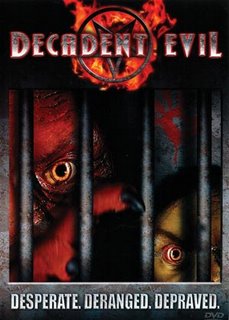
I've just discovered the existence of this film in cyberspace. Its obviously low budget, B grade and is probably incredibly awful; yet it looks so much fun that I had to share it with you and it is on my (rather long) to buy list.
The films synopsis is:
Marvin is a nasty, horny homunculus, part human/part reptile, who stands 12 inches tall and lives alone, trapped inside a birdcage. Once completely human, Marvin was turned into a homunculus after his lover Morella (Debra Mayer), a 100 year old vengeful vampire, learned of his betrayal with another human. Set at the "Meat Market", a decadent strip-club, the male clientele unknowingly become victims of Morella and the sexy young vampire strippers Sugar and Spyce (Jill Michelle and Raelyn Hennessee). As Morella executes her final kills to become the most powerful vampire of all, Marvin's son, Ivan (Phil Fondacaro), standing three ferocious feet tall, plans his ultimate revenge against her...
So we have a vampire movie that includes a puppet of a homunculus, if you need any more convincing nip over to the Film Asylum, where you'll find a link to a trailer.
Posted by
Taliesin_ttlg
at
10:36 PM
2
comments
![]()
Rise (and more)
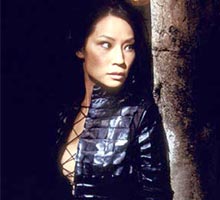
If you nip over to Ghost House Pictures, you'll find the page for "Rise" a new film staring Lucy Liu that has - as far as I can tell - wrapped up production. The site has the following synopsis for the movie:
Rise is a supernatural thriller in which a reporter (Liu) wakes up in a morgue to discover she is no longer among the living. She vows revenge against the cult responsible for putting her there and hunts them down one by one. Chiklis plays "Rawlins," a haunted police detective whose daughter is killed by the same cult and seeks answers for her gruesome death.
In other news from the same production company, it has been announced that David Slade is to direct the Sam Rami and Rob Tapert production of "30 days of Night". The film is based on the wonderful graphic novel by Steve Niles - expect a review of the graphic novel here, soon.
Posted by
Taliesin_ttlg
at
12:49 AM
2
comments
![]()
At the Zombie Astronaut
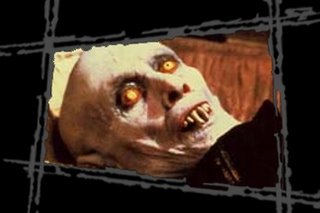
The Zombie Astronaut is a wonderful site that posts many horror, sci-fi and suspense radio shows.
Currently at the site, under issue 15 (February 2006) and the Last Requests section, is the complete radio show of 'Salem's Lot. This is the BBC version, with Doug Bradley as Barlow.
A fine piece of radio drama and worth picking up. Many thanks to the Astronaut for making this available.
Posted by
Taliesin_ttlg
at
12:39 AM
0
comments
![]()

